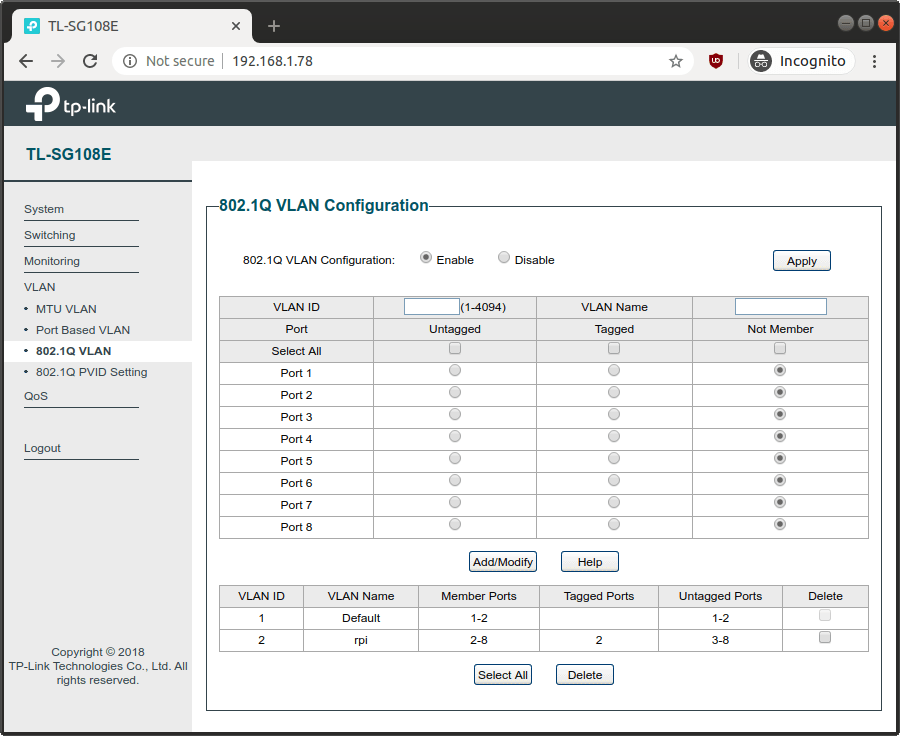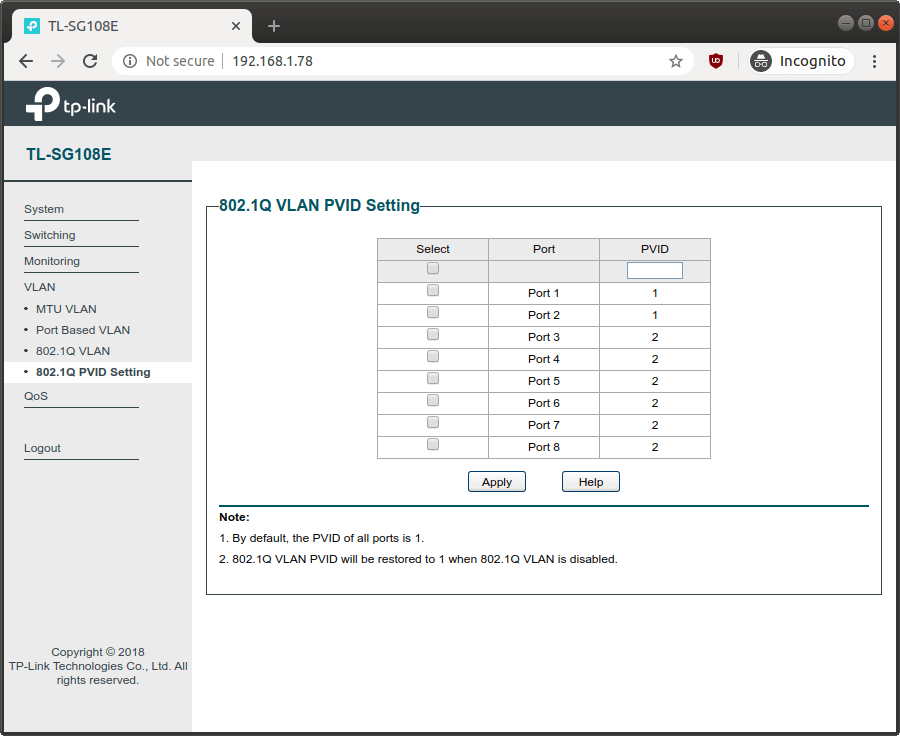This is a Vagrant Environment for a Preboot Execution Environment (PXE) gateway for Raspberry Pis.
This gateway environment is made with isc-dhcp-server (as the DHCP server) and atftpd (as the TFTP server.
In order for it to work you need to connect the gateway virtual network to a physical network that reaches the Raspberry Pis.
I'm using Ubuntu 20.04 as the host, qemu/kvm/libvirt has the hypervisor, and a tp-link tl-sg108e switch.
The network is connected as:
The tp-link tl-sg108e switch is configured as:
NB this line of switches is somewhat insecure as, at least, its configuration protocol (UDP port 29808 and TCP port 80) uses clear text messages. For more information see How I can gain control of your TP-LINK home switch and Information disclosure vulnerability in TP-Link Easy Smart switches.
The host network is configured by netplan with /etc/netplan/config.yaml as:
network:
version: 2
renderer: networkd
ethernets:
enp3s0:
dhcp4: yes
nameservers:
# NB on ubuntu this normally uses the system-resolved dns resolver and
# you can list the current upstream dns server addresses with:
# systemd-resolve --status
addresses:
# cloudflare+apnic public dns resolvers.
# see https://en.wikipedia.org/wiki/1.1.1.1
- "1.1.1.1"
- "1.0.0.1"
# google public dns resolvers.
# see https://en.wikipedia.org/wiki/8.8.8.8
#- "8.8.8.8"
#- "8.8.4.4"
bridges:
# NB this is equivalent of executing:
# ip link add name br-rpi type bridge
# ip addr flush dev br-rpi
# ip addr add dev br-rpi 10.10.10.1/24
# ip link set dev br-rpi up
# ip addr ls dev br-rpi
# ip -d link show dev br-rpi
# ip route
# NB later, you can remove with:
# ip link set dev br-rpi down
# ip link delete dev br-rpi
br-rpi:
addresses:
- "10.10.10.1/24"
interfaces:
- vlan2
vlans:
# NB this is equivalent of executing:
# ip link add link enp3s0 vlan2 type vlan proto 802.1q id 2
# ip link set dev vlan2 up
# ip -d link show dev vlan2
# NB later, you can remove with:
# ip link set dev vlan2 down
# ip link delete dev vlan2
vlan2:
id: 2
link: enp3s0Edit provision-images.sh to select which image is installed by default.
After the above is in place, run vagrant up gateway to launch the gateway.
For more information about VLANs see the IEEE 802.1Q VLAN Tutorial.
Create a Raspios Lite sd-card with balenaEtcher, put it in your pi and boot from it.
Login with the pi username and raspberry password.
Then configure it with:
# switch to root.
sudo su -l
# disable automatic flash updates.
systemctl mask --now rpi-eeprom-update
# update the system.
apt-get update
apt-get upgrade -y
# reboot.
reboot
# switch to root.
sudo su -l
# disable auto-login.
raspi-config nonint do_boot_behaviour B3
# replace vnc with rdp.
# NB on your computer, you can use the following command to rdp into your pi:
# xfreerdp /v:raspberrypi.local /u:pi /p:raspberry /size:1440x900 +clipboard
apt-get remove -y --purge realvnc-vnc-server
apt-get install -y xrdp
# remove unneeded packages.
apt-get autoremove -y --purgeRPi4 has two firmware images:
pieepromstored in the SPI-attached FLASH (aka EEPROM; 4MBits/512KB) and used by the SoC as a bootloader. For more information see https://www.raspberrypi.org/documentation/hardware/raspberrypi/booteeprom.md.vl805stored in the USB controller FLASH (aka EEPROM) and used by it.
NB In theory its not possible to brick the RPi, if something is not working as expected, just use a recovery sdcard as described by the recovery instructions.
NB the RPi4 firmware is not open-source (and probably will never be).
There are two flash image channels:
critical: contains the stable/finished firmware.beta: contains the testing/development firmware (e.g. currently, this is the only one that has support for PXE network booting).
They are stored at /lib/firmware/raspberrypi/bootloader/*/*.bin (were installed the rpi-eeprom-images package; they are also available at https://github.com/raspberrypi/rpi-eeprom/tree/master/firmware), e.g.:
/lib/firmware/raspberrypi/bootloader/beta/pieeprom-2020-04-16.bin
/lib/firmware/raspberrypi/bootloader/beta/vl805-000137ad.bin
/lib/firmware/raspberrypi/bootloader/critical/pieeprom-2020-04-16.bin
/lib/firmware/raspberrypi/bootloader/critical/vl805-000137ad.bin
To flash a image we use the rpi-eeprom-update command.
For example, to flash a critical bootloader with its default configuration, use:
rpi-eeprom-update -d -f /lib/firmware/raspberrypi/bootloader/critical/pieeprom-2020-04-16.bin
rebootNB The above will create the following files in the sd-card /boot directory:
-rwxr-xr-x 1 root root 65 Feb 8 16:06 pieeprom.sig*
-rwxr-xr-x 1 root root 524288 Feb 8 16:06 pieeprom.upd*
-rwxr-xr-x 1 root root 60820 Feb 8 16:06 recovery.bin*
NB The pi 4 rom will always run recovery.bin if it exists, that way, the pi can be recovered by using a recovery sd-card.
NB The default flashing procedure using recovery.bin only reads files from the sd-card, even when the pi is configured to boot from the network.
At the next boot, the upgrade will be applied by recovery.bin and when it successfully flashes the firmware, it will rename itself. If it fails to rename itself (or a power failure happened), the process repeats it self at the next boot.
For more details see:
- https://github.com/raspberrypi/rpi-eeprom/blob/master/firmware/release-notes.md
- https://www.raspberrypi.org/documentation/hardware/raspberrypi/bcm2711_bootloader_config.md
- https://www.raspberrypi.org/documentation/hardware/raspberrypi/booteeprom.md
- https://leiradel.github.io/2019/01/06/SmartStart.html
- https://leiradel.github.io/2019/01/20/Raspberry-Pi-Stubs.html
See which version you have now by executing rpi-eeprom-update, e.g.:
BCM2711 detected
Dedicated VL805 EEPROM detected
BOOTLOADER: up-to-date
CURRENT: Thu 16 Apr 17:11:26 UTC 2020 (1587057086)
LATEST: Thu 16 Apr 17:11:26 UTC 2020 (1587057086)
FW DIR: /lib/firmware/raspberrypi/bootloader/critical
VL805: up-to-date
CURRENT: 000137ad
LATEST: 000137ad
To flash a bootloader with customized settings, e.g., to boot from a PXE server:
# check the current bootloader version and config.
vcgencmd bootloader_version
vcgencmd bootloader_config
# extract the configuration file.
cp /lib/firmware/raspberrypi/bootloader/critical/pieeprom-2020-04-16.bin pieeprom.bin
rpi-eeprom-config pieeprom.bin >bootconf.txt
# see the configuration file.
cat bootconf.txt
# in my case it was:
# [all]
# BOOT_UART=0
# WAKE_ON_GPIO=1
# POWER_OFF_ON_HALT=0
# DHCP_TIMEOUT=45000
# DHCP_REQ_TIMEOUT=4000
# TFTP_FILE_TIMEOUT=30000
# TFTP_IP=
# TFTP_PREFIX=0
# BOOT_ORDER=0x1
# SD_BOOT_MAX_RETRIES=3
# NET_BOOT_MAX_RETRIES=5
# [none]
# FREEZE_VERSION=0
# save a copy to compare after we change it.
cp bootconf.txt{,.orig}
python3 <<'EOF'
import configparser
config = configparser.RawConfigParser()
config.optionxform = str
config.read('bootconf.txt')
# disable wake on GPIO because I do not need it.
# NB default is 1.
config.set('all', 'WAKE_ON_GPIO', '0')
# really power-off everything.
# NB this only leaves the 5v rails on.
# NB this is only applicable when WAKE_ON_GPIO=0,
# NB default is 0.
config.set('all', 'POWER_OFF_ON_HALT', '1')
# enable network boot.
# change BOOT_ORDER from 0x1 (sd-boot) to 0x2 (network boot).
# NB default is 0x1.
# NB if something goes wrong you can always follow the recovery procedure described at https://www.raspberrypi.org/downloads.
# see https://www.raspberrypi.org/documentation/hardware/raspberrypi/bcm2711_bootloader_config.md
config.set('all', 'BOOT_ORDER', '0x2')
# retry forever.
config.set('all', 'NET_BOOT_MAX_RETRIES', '-1')
# identify this RPi as rpi1 to the TFTP server.
config.set('all', 'TFTP_PREFIX', '1')
# request tftp files using this prefix (if that fails, it will try again, without the prefix).
# the bootloader will request the following files (until one of them exists):
# rpi1/start4.elf
# rpi1/start.elf
# config.txt
# recover4.elf
# recovery.elf
# start4.elf
# start.elf
config.set('all', 'TFTP_PREFIX_STR', 'rpi1/')
# enable the boot UART to help debug (network) boot issues that might arise.
# NB you need a UART/console cable connect to the RPi and to a computer.
# to connect to the UART use picocom --baud 115200 /dev/ttyUSB0.
# to quit picocom type Ctrl+A, Ctrl+X.
# NB default is 0.
config.set('all', 'BOOT_UART', '1')
with open('bootconf.txt', 'w') as f:
config.write(f, space_around_delimiters=False)
EOF
# see the differences to make sure everything is OK.
diff -u bootconf.txt{.orig,}
# apply the configuration change to a new pieeprom-netboot.bin image file.
rpi-eeprom-config --out pieeprom-netboot.bin --config bootconf.txt pieeprom.bin
# flash the pi.
#
# there are two ways to flash the pi:
#
# 1. power-off resilient
# NB this requires a sd-card to be present.
# 2. non power-off resilient.
# NB if the power is lost while flashing, you need to recover the flash using the recovery sd-card.
#
# if we have an sdcard, prefer that method, even when booted from the network.
if [ "$(lsblk /dev/mmcblk0p1 -o LABEL | tail -n +2)" == "boot" ]; then
# configure the device to be flashed at the next boot.
rpi-eeprom-update -d -f pieeprom-netboot.bin
# if the sd-card is not mounted we assume we are booting from the network,
# as such, rpi-eeprom-update left the files in the network share instead
# of the sd-card, so, we just copy the entire /boot tree to the boot
# partition.
sd_card_boot_mountpoint="$(lsblk /dev/mmcblk0p1 -o MOUNTPOINT | tail -n +2)"
if [ "$sd_card_boot_mountpoint" == '/media/pi/boot' ]; then
# NB this is normally automatically mounted by raspios, but we
# need to re-mount it as root.
umount /media/pi/boot
sd_card_boot_mountpoint=''
fi
if [ "$sd_card_boot_mountpoint" == "" ]; then
# when the current system boots from the network we must put the
# files in the sd-card boot partition (because the pi bootloader
# can only load them from the sd-card).
mkdir -p /media/pi-boot
mount /dev/mmcblk0p1 /media/pi-boot
rsync -a --delete /boot/ /media/pi-boot/
umount /media/pi-boot
rmdir /media/pi-boot
fi
else
# flash it right now.
rm -f /boot/{recovery.bin,pieeprom.*}
USE_FLASHROM=1 rpi-eeprom-update -d -f pieeprom-netboot.bin
fi
# reboot to apply changes.
rebootAfter reboot you should verify that the device is using the expected bootloader configuration:
vcgencmd bootloader_version
vcgencmd bootloader_configYou can see all the network traffic from within the gateway by running:
vagrant ssh-config gateway >tmp/gateway-ssh-config.conf
wireshark -k -i <(ssh -F tmp/gateway-ssh-config.conf gateway 'sudo tcpdump -s 0 -U -n -i eth1 -w - not tcp port 22')You can also do it from the host by capturing traffic from the br-rpi or vlan2 interface.
- https://www.raspberrypi.org/documentation/hardware/raspberrypi/bootmodes/net_tutorial.md
- https://www.raspberrypi.org/documentation/hardware/raspberrypi/booteeprom.md
- https://www.raspberrypi.org/documentation/hardware/raspberrypi/bcm2711_bootloader_config.md
- https://leiradel.github.io/2019/01/06/SmartStart.html
- https://leiradel.github.io/2019/01/20/Raspberry-Pi-Stubs.html
- https://www.raspberrypi.org/documentation/hardware/raspberrypi/schematics/README.md
- https://www.raspberrypi.org/documentation/configuration/boot_folder.md
- https://www.raspberrypi.org/documentation/configuration/
- https://github.com/raspberrypi/rpi-eeprom/blob/master/firmware/raspberry_pi4_network_boot_beta.md
- https://github.com/raspberrypi/rpi-eeprom/blob/master/firmware/release-notes.md
- https://github.com/raspberrypi/linux
- https://github.com/pftf
- https://www.kernel.org/doc/Documentation/filesystems/nfs/nfsroot.txt
- https://github.com/RPi-Distro/pi-gen
- IEEE 802.1Q VLAN Tutorial


